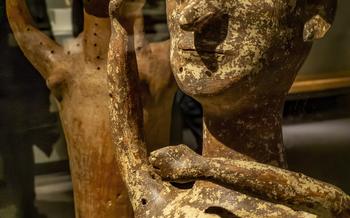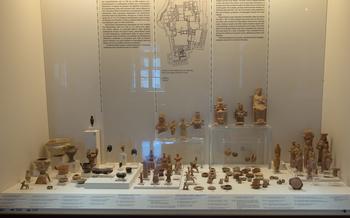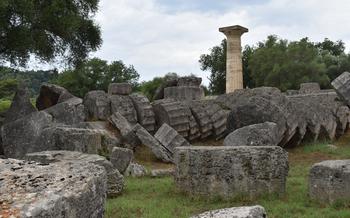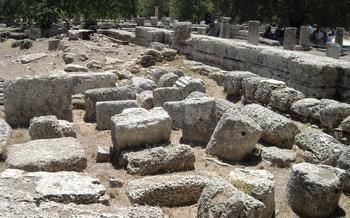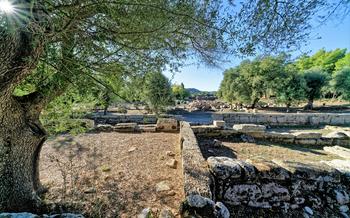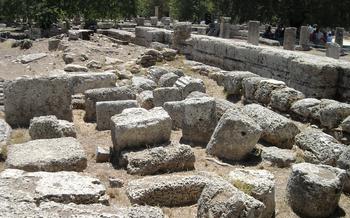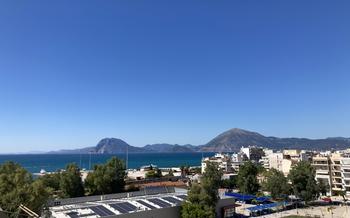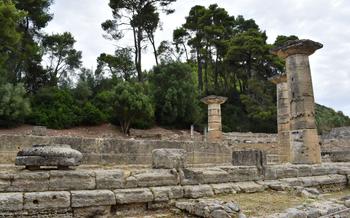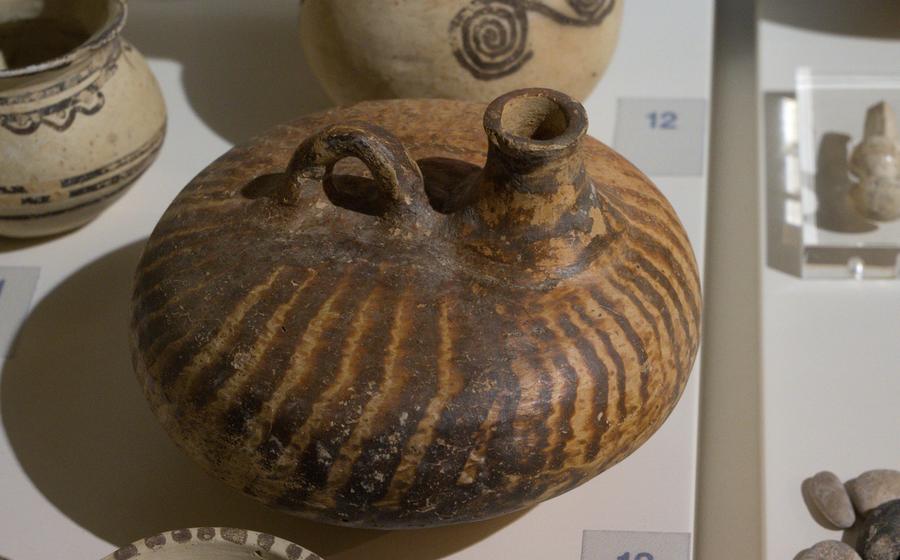
The Heraion of Perachora
- History of the Temple
- Excavations and Discoveries
- Architectural Features
- Offerings and Dedications
- Temple's Decline and Abandonment
- Rediscovery and Restoration
- Temple's Surroundings
- Visiting the Heraion
- Local Cuisine and Hospitality
- Photography and Social Media
- Insider Tip: Explore the Hidden Gems of the Peloponnese
History of the Temple
The Heraion of Perachora, nestled on a hill overlooking the Gulf of Corinth, holds a significant place in Greek mythology and history. The temple, dedicated to the goddess Hera, wife of Zeus and queen of the gods, was constructed in the 7th century BC. Its origins are deeply rooted in mythology, as it was believed to be the site where Hera was worshiped by the local population even before the construction of the temple. The temple's construction marked a shift from simple shrines to monumental Doric temples, becoming a testament to the growing power and influence of the goddess. The architectural style of the temple, characterized by its simplicity and harmony, exemplifies the transition from the Archaic to the Classical period in ancient Greek architecture, making it a significant landmark in the history of Greek temple construction.
Excavations and Discoveries
The Heraion of Perachora has been the subject of extensive archaeological excavations since the 19th century. These excavations have unearthed a wealth of significant artifacts, including sculptures, pottery, and inscriptions, which have shed light on the temple's history and religious practices.
One of the most notable discoveries was a series of sculptures depicting the goddess Hera. These sculptures, which date back to the 6th century BC, provide valuable insights into the iconography and worship of Hera. Other important finds include a large number of pottery fragments, which have helped archaeologists to reconstruct the temple's history and chronology.
The excavations were led by a number of prominent archaeologists, including Oscar Broneer and Richard Tomlinson. Broneer, who conducted excavations at the site in the 1930s, uncovered the temple's foundations and identified the different architectural phases of the building. Tomlinson, who worked at the Heraion in the 1950s and 1960s, focused on the temple's cult practices and discovered a number of votive offerings that had been left by worshippers.
The ongoing research and discoveries at the Heraion of Perachora continue to shed light on the temple's history and rituals. Recent excavations have revealed new evidence of the temple's construction and decoration, as well as the activities that took place within its sacred precinct. These discoveries are helping to piece together a more complete picture of this important religious center in ancient Greece.
Architectural Features
The Heraion of Perachora, a notable example of Doric architecture, showcases a refined and harmonious design. The temple's layout follows the typical tripartite division, comprising the cella, pronaos, and opisthodomos. The cella, the innermost chamber, housed the cult statue of Hera, while the pronaos served as the entrance porch, featuring two rows of columns supporting the entablature. The opisthodomos, located at the rear of the temple, was likely used for storing offerings and valuables.
The exterior of the temple is adorned with 18 Doric columns, six on each side and six across the front and back. These columns, characterized by their simple and elegant design, consist of a fluted shaft resting on a circular base and topped by a square capital. The entablature, the horizontal structure above the columns, comprises three elements: the architrave, a plain stone beam; the frieze, featuring alternating triglyphs (vertical rectangular blocks) and metopes (square panels adorned with bas-relief sculptures); and the cornice, a projecting molding that crowns the entablature.
The pediments, the triangular gables at the front and back of the temple, originally displayed elaborate sculptures depicting scenes from Greek mythology. Unfortunately, these sculptures have been lost over time, leaving only fragments and descriptions to hint at their grandeur. The temple's foundations consist of large limestone blocks, expertly fitted together without the use of mortar. The building materials primarily comprise local limestone and poros stone, contributing to the temple's enduring presence in the landscape.
The Heraion of Perachora stands in comparison with other significant Doric temples in Greece, such as the Parthenon in Athens and the Temple of Zeus at Olympia. While sharing the same architectural style, each temple exhibits unique characteristics that reflect the specific context and period of its construction. The Heraion, with its serene setting overlooking the Gulf of Corinth, offers a glimpse into the architectural achievements of ancient Greece and the enduring legacy of the goddess Hera.
Offerings and Dedications
At the Heraion of Perachora, the goddess Hera received a multitude of offerings from her devoted worshippers. These offerings, ranging from humble pottery to exquisite works of art, provide valuable insights into the religious practices and beliefs of ancient Greece.
Excavations at the site have unearthed a treasure trove of votive objects, including terracotta figurines, bronze statuettes, and jewelry. These offerings often depicted Hera herself, her sacred animals, or scenes from her mythology. The discovery of these objects sheds light on the personal devotions and petitions made by individuals seeking the goddess's favor or protection.
Inscriptions found on some of the offerings reveal the names and dedications of the donors. These inscriptions offer glimpses into the lives of ordinary Greeks who sought to honor Hera and express their gratitude or supplication. The offerings also provide insights into the economic and social status of the temple's patrons, as well as the types of goods that were valued and exchanged in ancient Greece.
The analysis of these offerings allows us to understand the deep connection between the worshippers and the divine realm. The variety and richness of the offerings reflect the significance of the Heraion as a religious center and the enduring devotion to the goddess Hera.
Temple's Decline and Abandonment
The grandeur of the Heraion of Perachora did not last forever, as it eventually fell into decline and abandonment. The reasons for this are manifold and complex, reflecting the ever-changing nature of ancient Greek society and religious practices.
One contributing factor was the rise of Christianity in the Roman Empire. As the new religion spread, traditional Greek religious practices, including the worship of Hera, were gradually marginalized and replaced. The Heraion, once a bustling center of religious devotion, became increasingly neglected and abandoned.
Natural disasters and wars also played a role in the temple's decline. The site was subjected to several earthquakes over the centuries, which caused significant damage to the structure. Additionally, the region was frequently embroiled in conflicts, including the Peloponnesian War, which further contributed to the temple's deterioration.
Over time, the once-magnificent temple fell into ruin, its once-vibrant colors fading away, its grand columns crumbling to the ground. The site was eventually abandoned, left to the mercy of time, nature, and the occasional passerby.
Despite its decline and abandonment, the Heraion of Perachora remains a testament to the architectural prowess and religious devotion of the ancient Greeks. Its ruins, though weathered and worn, still evoke a sense of awe and wonder, reminding us of the enduring legacy of this once-great sanctuary.
Rediscovery and Restoration
The rediscovery of the Heraion of Perachora in modern times is a fascinating story of archaeological exploration and perseverance. In the 19th century, travelers and scholars began to take an interest in the ruins of the temple, which had been largely forgotten and overgrown with vegetation. In the 1880s, the Greek Archaeological Society conducted the first excavations at the site, unearthing fragments of columns, sculptures, and pottery.
The most significant excavations, however, were carried out by the American School of Classical Studies at Athens in the 1930s and 1940s, led by archaeologist Oscar Broneer. Broneer's team uncovered the majority of the temple's remains, including the foundations, columns, and pediments. They also discovered a large number of votive offerings and inscriptions, which shed light on the temple's cult and rituals.
After the excavations, the Greek Archaeological Service undertook the restoration of the Heraion. The temple's columns were re-erected, and the foundations and walls were reinforced. The site was also landscaped and made accessible to visitors. Today, the Heraion of Perachora stands as a testament to the enduring power of ancient Greek architecture and the dedication of archaeologists who have worked to preserve it for future generations.
Temple's Surroundings
The Heraion of Perachora is nestled amidst a captivating natural landscape that enhances its historical significance. The temple is surrounded by gently rolling hills, lush vegetation, and the tranquil waters of the Corinthian Gulf. Visitors can wander through the picturesque countryside, taking in the breathtaking views and the serene atmosphere.
In the vicinity of the temple, several archaeological remains have been discovered, providing valuable insights into the ancient city of Perachora. These remains include foundations of buildings, pottery fragments, and other artifacts that offer glimpses into the daily lives and activities of the people who once inhabited this region.
Exploring the temple's surroundings offers a holistic understanding of its historical context. Visitors can appreciate how the natural environment influenced the construction and significance of the Heraion. The harmonious relationship between the temple and its surroundings adds to its charm and allure, making it a must-visit destination for anyone interested in ancient history, archaeology, and the beauty of the Greek landscape.
Nearby attractions, such as the ancient city of Corinth, further enrich the experience of visiting the Heraion. Corinth, with its impressive ruins and rich history, provides a glimpse into the broader context of ancient Greece and its cultural achievements. Combining a visit to the Heraion with other nearby sites offers a comprehensive exploration of the region's historical and archaeological treasures.
Visiting the Heraion
Planning a visit to the Heraion of Perachora is an enriching experience that offers a glimpse into the ancient world. The temple is open to the public daily, with varying hours depending on the season. Admission fees are minimal, and concessions are available for students and seniors. Accessibility for visitors with disabilities is limited due to the uneven terrain and lack of designated pathways, but assistance can be provided upon request.
When visiting the Heraion, it is recommended to choose the right time of day to avoid the harsh midday sun and take advantage of the beautiful golden light during sunrise and sunset. Guided tours are available for a more in-depth understanding of the site's history and significance, and visitors are encouraged to explore the temple independently, allowing ample time to soak in the atmosphere and capture the essence of this sacred place.
Combining a visit to the Heraion with other attractions in the region is highly recommended. The nearby ancient city of Corinth, with its rich history and impressive archaeological remains, is a must-see. The Peloponnese region offers a wealth of stunning beaches, picturesque villages, and natural wonders, providing a perfect opportunity to explore the diverse landscapes and cultural heritage of Greece.
Local Cuisine and Hospitality
Exploring the region surrounding the Heraion of Perachora presents a delightful opportunity to savor the authentic flavors of Greek cuisine. Traditional dishes, prepared with fresh, local ingredients, await visitors in the charming tavernas and restaurants dotting the area. Indulge in mouthwatering seafood delicacies, succulent grilled meats, and an array of flavorful vegetarian options.
Local establishments take pride in their culinary heritage, offering dishes that have been passed down through generations. From the aromatic moussaka to the refreshing tzatziki, each bite promises a taste of Greece's rich culinary tapestry. Be sure to sample the region's renowned wines, produced from grapes grown in the fertile Peloponnesian soil.
Beyond the delectable cuisine, the people of Perachora are renowned for their warm hospitality. Welcoming smiles and friendly conversations are the norm, making every interaction a delightful experience. Engage with the locals, learn about their customs and traditions, and immerse yourself in the vibrant culture of the region.
Supporting local businesses is essential for preserving the culinary traditions and vibrant atmosphere of the area. By dining at local establishments, visitors contribute directly to the community's economic well-being and help ensure that these cherished traditions continue to thrive. Embrace the opportunity to connect with the locals, savor the authentic flavors of Greek cuisine, and create lasting memories in this welcoming and hospitable region.
Photography and Social Media
The Heraion of Perachora offers a treasure trove of photo opportunities, with its ancient columns, picturesque surroundings, and stunning views of the Gulf of Corinth. Capture the essence of this historical site through your lens, experimenting with different angles and lighting conditions to create captivating shots. Share your experiences with the world on social media, using hashtags like #HeraionofPerachora and #AncientGreece to connect with other travelers and enthusiasts. Remember to respect the site's historical significance and follow responsible photography practices, ensuring that your actions do not damage or disturb the ruins.
Insider Tip: Explore the Hidden Gems of the Peloponnese
Your journey to the Heraion of Perachora doesn't have to end with the temple itself. Take advantage of your time in the Peloponnese to explore the region's hidden gems. Venture beyond the temple grounds and discover the picturesque villages, lush countryside, and secluded beaches that make this region so special.
Seek out the charming village of Loutraki, known for its thermal springs and beautiful coastal views. Immerse yourself in the local culture by visiting traditional tavernas, sampling the delicious cuisine, and engaging with the friendly locals.
For those seeking a more adventurous experience, embark on a hike through the surrounding mountains. Discover hidden trails that lead to breathtaking viewpoints and secluded swimming spots. The Peloponnese is a treasure trove of natural beauty, waiting to be explored.
Don't miss the opportunity to combine your visit to the Heraion with other nearby attractions. The ancient city of Corinth, with its rich history and well-preserved ruins, is just a short drive away. And for those seeking sun and sea, the stunning beaches of the Peloponnese coastline are within easy reach.
Embrace the chance for cultural exchange and create lasting memories as you explore the hidden gems of the Peloponnese. Let the spirit of ancient Greece guide your journey as you uncover the region's rich history, natural wonders, and warm hospitality.
